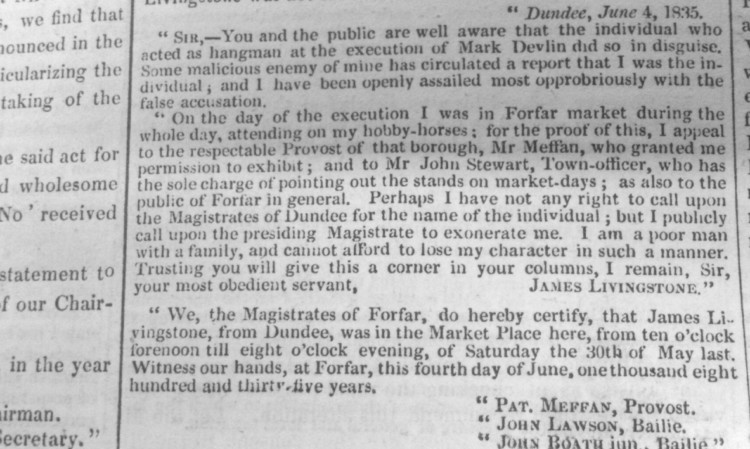Few mysteries remain unsolved forever but there is one in our archives that has remained a puzzle for nearly 180 years. It is the identity of the hangman who dispatched Mark Devlin in an attempt to smash the power of the Black Band criminal gang.
This ruthless secret society held Dundee in a grip of terror in the 1830s. They were thought to be based in a cellar in Overgate, at that time a place of shadows and secrets. They used the cover of this medieval warren of properties to spark riots, launch break-ins and highway robberies.
The Black Band fanned out across the booming city and never struck in the same district twice. Dundee’s new and tiny police force of 14 officers could not handle the gang’s crime wave. But in February 1835 they got lucky. They caught Devlin, a young Irishman, carrying out a break-in. He was sentenced to hang at Dundee on May 30.
The magistrates had a problem though. The town had not had a hangman since the 1745 rebellion. The post had become so unpopular because of the hanging of popular Jacobites that no one would take it.
So a young bailie arranged for an executioner to come from Edinburgh.
The window frame was removed from the Guild Hall within the Town House and a platform erected outside. The pulley was inside.
The execution was timed for 2pm but the Edinburgh hangman did not show.
The race to find a replacement was always going to be hard. While the townspeople enjoyed the free entertainment of a public hanging, they also loved to hate the hangman.
With just an hour to go, a volunteer was found who was willing to try his hand at execution. He demanded to wear a mask to conceal his identity.
By 2pm, about 15,000 people packed the High Street. When the hooded hangman came into sight, speculation rippled through the crowd. Then word went round like lightning and within a minute, the throng “knew” the hangman’s identity. He was James Livingstone, a travelling fairground showman.
As Devlin appeared, flanked by two priests, the hush of the crowd was broken by a woman’s wailing. Devlin raised his cap, shook hands with the sheriff and magistrates and made a penitent speech before being dispatched to eternity.
Meanwhile, in Forfar, James Livingstone was operating his merry-go-round, unaware of the character assassination going on in Dundee. But by evening he heard the first rumours which grew over the coming days, threatening to destroy his name and business.
In exasperation, he wrote to the Dundee Advertiser denying involvement and citing as witnesses, Provost Meffan of Forfar and Town Officer John Stewart. The letter was countersigned by Meffan and the Forfar magistrates.
This was enough to clear his reputation but the true identity of the hooded hangman was never revealed. All that is known is he was a native of Dundee. The junior bailie who appointed him took the secret to his grave.
